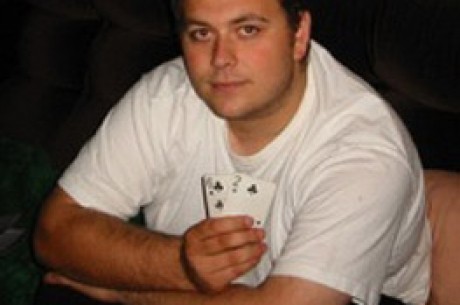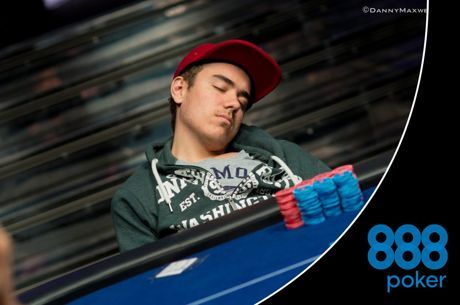H.O.R.S.E. Poker Strategy: In the Mix -- Outdrawn and Quartered in Omaha Hi/Lo

Last week we took a look at a situation that happens all too frequently in seven-card stud hi/lo — a player with no qualifying low hand who gets freerolled for the high half of the pot by a player with a made low. The long and short of the situation is that in split-pot games, a player's chances of having a profitable session are maximized by going for a scoop rather than by playing for only half of the pot.
As a corollary to last week's article, this week we are going to take a look at the other split-pot game that is often included in any mixed-game rotation: Omaha hi/lo. The difference is that instead of being concerned about being freerolled for the high half of the pot, a far more common situation in Omaha hi/lo is being quartered for the low half of the pot. This happens frequently in Omaha hi/lo, especially at the lower limits, because of the fact that Omaha hi/lo uses community cards (as opposed to stud hi/lo, where each player plays his own board) and because in a hi/lo game, it's very easy to see the value of holding ace-deuce or ace-trey as two of your four starting cards.
Getting quartered in a pot is almost always a minor disaster. Very rare is the pot that is played all the way to the river by four or more players. Even in the case where four players have called every bet to showdown, a player who is quartered will simply get his money back (minus one-fourth of the rake). A much more likely scenario is that only two or three players have even gone to the turn, never mind the river. In that situation, getting quartered turns the hand from a small win into a small loss. Yet folding starting hands that contain ace-deuce or ace-trey preflop can't be the right response to avoid a quartering situation, can it?
Of course not. Most poker literature on the value of starting Omaha hi/lo hands would rank almost any hand with an ace-deuce in it as a playable hand (depending, of course, on the nature of the table and the player's position in the hand). Yet if the hand is only playable for its potential to make the nut low, then the player must be very mindful of the fact that other players may also have been dealt aces, deuces and/or treys and will be playing for the same reason. It's very easy to make the nut low in Omaha hi/lo, and very easy to see what the nut low will be after the flop has come out. Players will therefore stick around with nothing but a low draw in the expectation that if they hit, they will get half of the pot.
That flies in the face of good split-pot game strategy. In split-pot games, scooping both halves of the pot should always be the player's aim. If scooping isn't possible, at least try to get three-quarters. Getting only half should be the very last resort. If a player plays a hand solely for its value to make the nut low, he's giving up half of the pot straight from the start absent a very cooperative board.
Getting quartered for the high half of the pot is also possible, but it's much rarer due to the fact that before the flop comes out, it's impossible to predict what cards will make strong high hands. If the flop is all Broadway cards, then clearly Broadway cards are going to be involved in the hand that wins the high half of the pot. If the pot is all low cards, then it's going to be some small cards that win the high half of the pot (and this is also a very likely scenario for one player to scoop or at the very least to quarter another player out of half of the low). If the flop is a mix of high-and-low cards, or maybe some medium cards, then the high half of the pot could go to a very strange starting holding.
Yet always before the flop comes down, it is very clear that aces, deuces and treys will go a long way towards making the nuts for the low half of the pot. Thus the likelihood of getting quartered out of the low is much higher than it is for getting quartered out of the high. It's not uncommon to see two or even three people split the low half of the pot. Getting one-sixth of a pot is better than getting none of the pot, but it's not a road to profit or poker success.
Many low-limit players will scold other players who raise with the nut low on the big streets in Omaha hi/lo (the turn or the river). Since the likelihood of another player holding the same hand is higher than it is in other poker variants, a player who raises with only the nut low could very well be costing himself money when it turns out at showdown that he has been quartered. But there are no absolutes in poker. It's not correct to say that a player with only the nut low should never raise. He just needs to be mindful that even if he is sure two of his opponents are both going after the high, one of them could also be sitting on the nut low. There are four starting cards in Omaha hi/lo, and those four starting cards make six different two-card hands. One of the most common quartering situations is when a player starts A-2-3-x, with the ace and one of the other cards suited, and then makes the nut low and the nut flush.
In the end, there's no hard and fast way to avoid being quartered in Omaha hi/lo. It will happen, and it's always disappointing when it does. The best hope of mitigating the damage is by playing for both halves of the pot as much as possible, and being very cautious about raising with a made low when the high half of the pot is beyond your reach.








